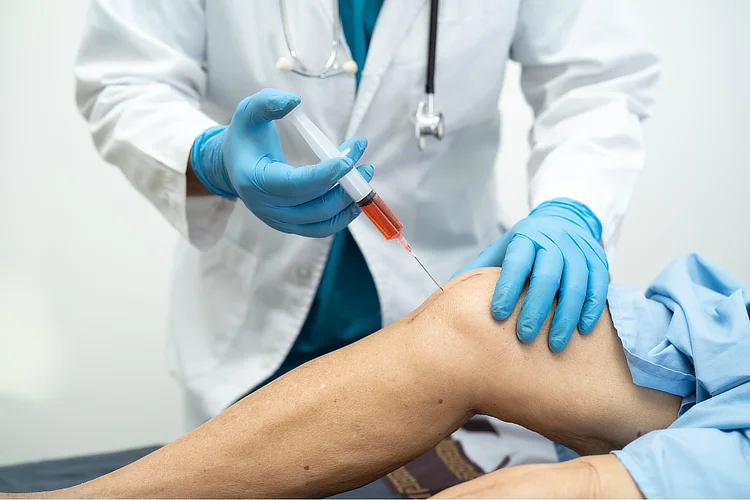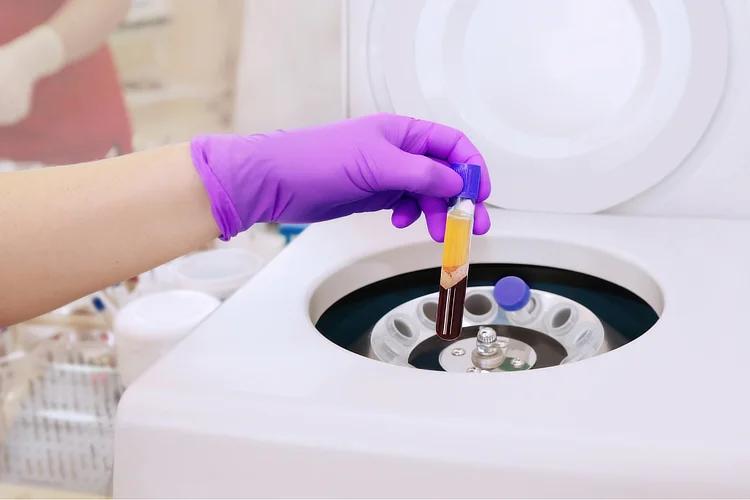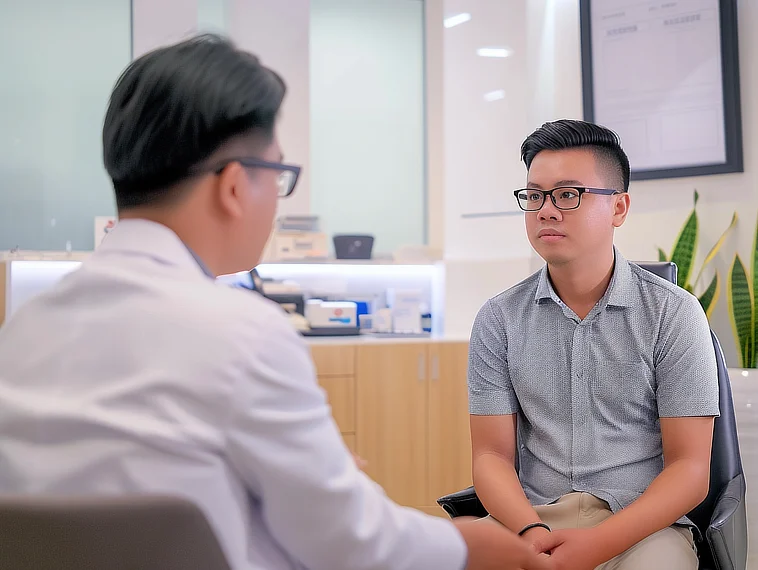Platelet-Rich Plasma (PRP) Treatment in Singapore
PRP treatment uses your body’s own platelets to promote healing in joints, tendons, and soft tissues. Dr Foo offers ultrasound-guided PRP injections to target inflammation, support tissue repair, and enhance recovery.
MBBS (University of London) | MMed (Ortho) | FRCSEd (Ortho) | FAMS (Ortho)


What Is Platelet-Rich Plasma (PRP) Therapy?

Platelet-rich plasma (PRP) therapy is a regenerative treatment that promotes tissue
repair and recovery by injecting a concentrated dose of the patient’s own
platelets, which are rich in growth factors and healing proteins.
By delivering a higher concentration of platelets, PRP therapy stimulates the body's natural
repair processes, particularly in injured tendons, ligaments, muscles, and joints. It is
used in orthopaedics and sports medicine to treat musculoskeletal injuries, reduce
inflammation, and support post-surgical healing.
At Apex Sports Clinic, we offer PRP therapy as a non-surgical treatment for sports
injuries, tendon and ligament damage, and degenerative joint conditions, to
support recovery.
How Does PRP Work?
PRP therapy supports the body’s natural healing by delivering a high concentration of platelets to injured tissues. These platelets release growth factors and proteins that support tissue repair, making PRP particularly effective for areas with poor blood supply, such as tendons and ligaments.
How PRP promotes healing:
- Reducing inflammation to ease pain and swelling.
- Stimulating cell repair to speed up soft tissue healing.
- Boosting collagen production, which strengthens tendons and ligaments.
- Improving blood flow to deliver oxygen and nutrients for faster recovery.
The effectiveness of PRP depends on the type and severity of the injury, overall health, and how the treatment is applied. It is often combined with physiotherapy, rehabilitation exercises, or other treatments to support recovery and improve long-term outcomes.
Injuries and Conditions That PRP Therapy Can Treat
PRP therapy is commonly used in orthopaedics and sports medicine to treat a range of musculoskeletal injuries and degenerative conditions, including:
| Injuries / Conditions | Description | Common Applications |
|---|---|---|
| Tendon Injuries | Chronic tendon injuries often result from repetitive strain and overuse, leading to pain, stiffness, and reduced mobility. PRP injections may stimulate healing and reduce inflammation. |
|
| Ligament Injuries | Ligaments, which connect bones and provide joint stability, heal slowly due to limited blood supply. PRP therapy may promote tissue repair and improve recovery. |
|
| Muscle Injuries | Muscle injuries result from overstretching, excessive force, or repetitive strain, leading to tears, weakness, and impaired function. PRP therapy may accelerate healing, reduce inflammation, and support recovery, particularly in athletes. |
|
| Osteoarthritis | PRP therapy has been studied for its potential to slow the progression of osteoarthritis by reducing joint pain, improving mobility, and enhancing joint function. It works by regulating inflammation and promoting tissue repair. |
|
| Post-Surgical Healing | PRP therapy can be used to enhance recovery after surgery, particularly for tendon, ligament, and joint procedures. It may reduce inflammation, improve tissue repair, and accelerate rehabilitation. |
|
While PRP therapy is widely used, its effectiveness varies based on the severity of the condition, the body's natural healing capacity, and the use of complementary treatments such as physiotherapy, among other factors.
PRP Injection: Step-by-Step Process

The PRP injection procedure typically takes 30 to 60 minutes and involves the following steps:
- Blood Collection – A small amount of blood (typically 15 to 30ml) is drawn from the patient’s arm.
- Centrifugation – The blood sample is placed in a centrifuge, where it is spun at high speeds to separate the platelets from other blood components.
- PRP Extraction – The concentrated platelet-rich plasma is carefully extracted and prepared for injection.
- Injection into the Affected Area – Using ultrasound guidance (if necessary), the PRP is injected directly into the injured tendon, ligament, muscle, or joint.
- Post-Injection Recovery – Patients are advised to limit strenuous activity for a few days and follow a prescribed rehabilitation programme, if applicable, to optimise healing.
Potential Side Effects of PRP Treatment
PRP is derived from the patient’s own blood, reducing the risk of allergic reactions or rejection. However, as with any medical procedure, there are potential risks and considerations, including:
- Temporary swelling, pain, or stiffness at the injection site.
- Bruising or mild discomfort post-injection.
- The need for multiple treatment sessions for optimal results.

Is PRP Therapy Right for You?
PRP may be suitable for individuals who:
- Have chronic tendon or ligament injuries that are not responding to standard treatments.
- Suffer from mild to moderate osteoarthritis and wish to delay or avoid surgery.
- Are athletes recovering from sports injuries seeking non-surgical options.
- Have undergone orthopaedic surgery and require enhanced healing.
PRP therapy may not be suitable for individuals with blood disorders (e.g., clotting disorders,
thrombocytopenia), active infections, or advanced
joint degeneration where surgical intervention is necessary.
It is best to consult with your specialist to determine if it is suitable for your health needs.
Cost of PRP Therapy in Singapore
The cost of PRP injections in Singapore varies depending on the treatment area and the number of sessions required. The estimated cost is:
| Treatment | Estimated Cost (SGD) |
|---|---|
| PRP Injection | From $1,000 – $1,500 |
Since PRP therapy is often combined with other treatments, the overall cost may include additional
fees for physiotherapy, imaging guidance (such as ultrasound), or specialist consultations.
PRP therapy is generally considered a regenerative treatment and may not be covered under most
standard insurance policies. However, some comprehensive or sports injury insurance plans may
provide partial coverage. It is best to check with your insurance provider for reimbursement
eligibility.
For a detailed cost estimate based on your condition, contact
us at Apex Sports Clinic.
Every patient deserves a treatment plan tailored to their needs. We start with non-surgical approaches before considering more invasive interventions.
Find Platelet-Rich Plasma (PRP) Treatment Near Me
Apex Novena
admin@apexsportsclinic.sg
101 Irrawaddy Rd, #18-12 Royal Square Medical Centre, Singapore 329565
Nearest MRT: NS20 Novena
Apex East Coast
admin@apexsportsclinic.sg
112 E Coast Rd, #03-03/04 i12 Katong, Singapore 428802
Nearest MRT: TE26 Marine Parade
Why Do Patients Choose Apex Sports Clinic?
Sports Doctor in Singapore: Personalised & Affordable Care
Progressive Treatment Philosophy
We prioritise personalised, non-invasive solutions, progressing to specialised treatments, including surgery, only when needed for more effective and targeted care.
Holistic Patient-Centred Care
From diagnosis to rehabilitation, we provide comprehensive and seamless care for a wide range of orthopaedic conditions.
Specialist in Sports Orthopaedics & Injury Management
We combine expert injury management with a proactive approach to maintaining your body’s strength and function, so you can recover fully and perform at your peak.
Patient Journey
1 . Schedule Your Appointment

2 . Expert Diagnosis & Consultation

3 . Customised Treatment Plan

Schedule an Appointment

Our Insurance Partners






Frequently Asked Questions (FAQs)
PRP injections may cause mild discomfort, as they involve drawing blood and injecting concentrated platelets into the affected area. Some patients describe a brief stinging or pressure sensation during the injection, particularly in joints or tendons. However, the procedure is generally well-tolerated, and any discomfort typically subsides quickly.
After a PRP injection, mild swelling, soreness, or stiffness may occur for a few days as part of the healing process. Pain relief and mobility improvements can take weeks, with some needing multiple sessions for the best results. Patients are typically advised to limit strenuous activity and follow a rehabilitation plan. It is best to consult a specialist on what to expect based on your condition and treatment plan.
The PRP procedure involves four main steps: drawing a small amount of the patient’s blood, processing it in a centrifuge to separate and concentrate platelets, extracting the PRP, and injecting it into the affected area. The entire process typically takes 30 to 60 minutes and may be performed with ultrasound guidance for precision.
Platelet-Rich Plasma (PRP) is a biological treatment used in orthopaedics to promote tissue healing and reduce inflammation in conditions such as tendon injuries, ligament sprains, muscle tears, and osteoarthritis. By delivering a high concentration of growth factors, PRP can help to accelerate recovery and may delay the need for surgery in some cases.
After a PRP injection, the body initiates a controlled inflammatory response, which plays a role in the healing process. This response supports cellular repair, increases blood flow to the treated area, and stimulates collagen production. Mild swelling and discomfort may occur initially, but these effects typically subside as healing progresses.
PRP therapy enhances the body's natural healing process by delivering a concentrated dose of platelets to injured tissues. These platelets release growth factors that can help repair tendons, ligaments, muscles, and cartilage while reducing pain and inflammation. PRP is commonly used for musculoskeletal injuries, osteoarthritis, and post-surgical recovery.
Yes, PRP therapy is legally available in Singapore and is offered at orthopaedic clinics, sports injury centres, and regenerative medicine facilities. Apex Sports Clinic provides PRP therapy for musculoskeletal conditions and sports injuries.
PRP injections typically range from SGD 1,000 to SGD 1,500. Costs vary based on the treatment area, number of sessions required, and additional procedures like ultrasound guidance or specialist consultations. Complementary treatments such as physiotherapy may also add to the overall cost of rehabilitation.
PRP therapy may not be suitable for individuals with blood disorders, active infections, or severe osteoarthritis requiring surgery. Those on blood thinners or with a history of cancer should also exercise caution. It is best to consult a specialist to determine if PRP is appropriate for your condition.
PRP therapy is costly due to the specialised processing equipment, the expertise required to administer the treatment, and the use of the patient’s own blood, which must be handled under strict medical protocols. Additionally, PRP injections are often performed with imaging guidance, further adding to the overall cost.
PRP therapy’s effectiveness depends on factors like the condition treated, overall health, and complementary treatments. Some patients, especially with advanced degeneration, may see little improvement. Multiple sessions are often needed, and insurance may not cover the cost. Temporary side effects like swelling, pain, or stiffness can also occur. It is best to consult a specialist to determine if PRP is a suitable option for your condition.
The effects of PRP therapy vary by individual. Many patients experience pain relief and improved function for several months to a year, but results depend on the severity of the condition, response to treatment, and adherence to rehabilitation efforts. It is best to consult a specialist to determine the most appropriate treatment plan for long-term management.
There is no strict limit on the number of PRP injections a person can receive, but repeated treatments may have diminishing returns. Most patients undergo one to three sessions per year, as excessive injections may not provide additional benefits. It is best to consult a specialist to determine the appropriate treatment frequency based on your condition and overall health.
PRP injections can cause mild to moderate discomfort, especially when administered near joints or tendons. However, the pain is usually brief and subsides shortly after the procedure. If necessary, your specialist can provide guidance on managing any post-injection discomfort.
Some doctors suggest limiting caffeine intake after PRP treatment as it may affect blood circulation and platelet function, which could influence the healing process. However, this recommendation is not universally required and may vary depending on individual cases. It is best to consult your specialist for personalised advice.
Stopping PRP therapy will not cause any direct adverse effects, but symptoms of the underlying condition may return over time. The progression of the condition depends on factors such as overall health, lifestyle, and other treatments being used. It is best to consult a specialist to determine the most suitable treatment approach for your recovery and long-term management.
PRP does not provide a permanent cure, but it can help improve symptoms and, in some cases, delay the need for more invasive treatments. Its effects depend on the condition, overall health, and adherence to a comprehensive treatment plan, which may include physiotherapy, lifestyle modifications, or other medical interventions. It is best to consult a specialist to determine the most suitable approach for long-term management.
PRP therapy can help to enhance the body's natural healing by stimulating tissue repair, reducing inflammation, and promoting cell regeneration in joints, tendons, muscles, and ligaments.
PRP may benefit those with mild to moderate musculoskeletal conditions seeking non-surgical pain relief and improved mobility. Its effectiveness varies depending on the condition, overall health, and complementary treatments. Patients with severe joint degeneration may see limited results. It is best to consult an orthopaedic specialist to determine if PRP is suitable for your health needs.
PRP therapy may cause mild discomfort during the injection, but it is generally well-tolerated. Pain levels vary depending on the treatment area and individual sensitivity.
One session of PRP therapy typically costs between SGD 1,000 and SGD 1,500, depending on the number of injections needed, ultrasound guidance, specialist consultations, and other complementary treatments like physiotherapy or rehabilitation, which may add to the overall cost of recovery.
The success rate of PRP varies depending on factors such as injury severity, overall health, and adherence to complementary treatments like physiotherapy. Research suggests it can be effective for tendon injuries and mild osteoarthritis.
The main downsides of PRP therapy include varying effectiveness depending on the condition, high costs, the need for multiple sessions, and temporary discomfort after injections. Additionally, PRP may not be suitable for advanced joint degeneration or certain medical conditions, making it essential to consult a specialist for personalised medical advice.

